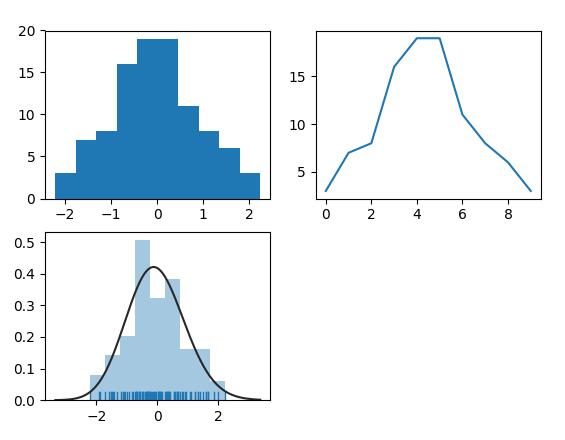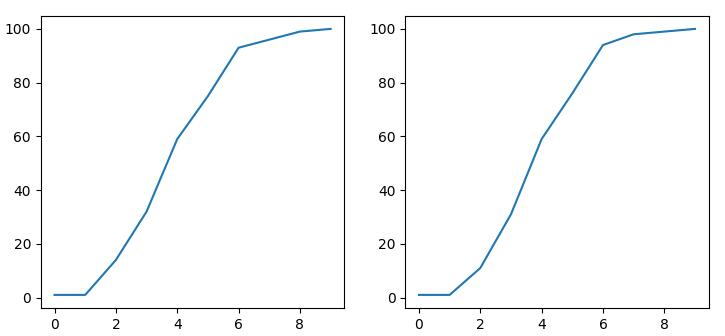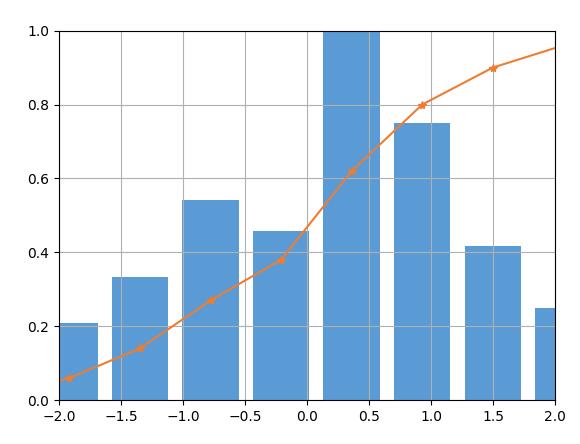您好,登錄后才能下訂單哦!
您好,登錄后才能下訂單哦!
這篇文章給大家分享的是有關Python如何處理PDF與CDF的內容。小編覺得挺實用的,因此分享給大家做個參考,一起跟隨小編過來看看吧。
在拿到數據后,最需要做的工作之一就是查看一下自己的數據分布情況。而針對數據的分布,又包括pdf和cdf兩類。
下面介紹使用python生成pdf的方法:
使用matplotlib的畫圖接口hist(),直接畫出pdf分布;
使用numpy的數據處理函數histogram(),可以生成pdf分布數據,方便進行后續的數據處理,比如進一步生成cdf;
使用seaborn的distplot(),好處是可以進行pdf分布的擬合,查看自己數據的分布類型;

上圖所示為采用3種算法生成的pdf圖。下面是源代碼。
from scipy import stats import matplotlib.pyplot as plt import numpy as np import seaborn as sns arr = np.random.normal(size=100) # plot histogram plt.subplot(221) plt.hist(arr) # obtain histogram data plt.subplot(222) hist, bin_edges = np.histogram(arr) plt.plot(hist) # fit histogram curve plt.subplot(223) sns.distplot(arr, kde=False, fit=stats.gamma, rug=True) plt.show()
下面介紹使用python生成cdf的方法:
使用numpy的數據處理函數histogram(),生成pdf分布數據,進一步生成cdf;
使用seaborn的cumfreq(),直接畫出cdf;

上圖所示為采用2種算法生成的cdf圖。下面是源代碼。
from scipy import stats import matplotlib.pyplot as plt import numpy as np import seaborn as sns arr = np.random.normal(size=100) plt.subplot(121) hist, bin_edges = np.histogram(arr) cdf = np.cumsum(hist) plt.plot(cdf) plt.subplot(122) cdf = stats.cumfreq(arr) plt.plot(cdf[0]) plt.show()
在更多時候,需要把pdf和cdf放在一起,可以更好的顯示數據分布。這個實現需要把pdf和cdf分別進行歸一化。

上圖所示為歸一化的pdf和cdf。下面是源代碼。
from scipy import stats import matplotlib.pyplot as plt import numpy as np import seaborn as sns arr = np.random.normal(size=100) hist, bin_edges = np.histogram(arr) width = (bin_edges[1] - bin_edges[0]) * 0.8 plt.bar(bin_edges[1:], hist/max(hist), width=width, color='#5B9BD5') cdf = np.cumsum(hist/sum(hist)) plt.plot(bin_edges[1:], cdf, '-*', color='#ED7D31') plt.xlim([-2, 2]) plt.ylim([0, 1]) plt.grid() plt.show()
感謝各位的閱讀!關于“Python如何處理PDF與CDF”這篇文章就分享到這里了,希望以上內容可以對大家有一定的幫助,讓大家可以學到更多知識,如果覺得文章不錯,可以把它分享出去讓更多的人看到吧!
免責聲明:本站發布的內容(圖片、視頻和文字)以原創、轉載和分享為主,文章觀點不代表本網站立場,如果涉及侵權請聯系站長郵箱:is@yisu.com進行舉報,并提供相關證據,一經查實,將立刻刪除涉嫌侵權內容。